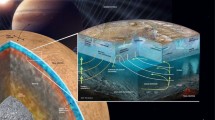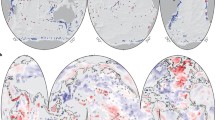Abstract
The resonance associated with the ellipticity of the core-mantle boundary is usually measured with observations of either the Earth’s nutations, or of tidal gravity, strain, or tilt. But, improbably, it can also be seen in a dataset collected and processed with older and simpler technologies: the harmonic constants for the ocean tides. One effect of the resonance is to decrease the ratio of the amplitude of the \(\mathrm{ P_1}\) constituent to the amplitude of the \(\mathrm{ K_1}\) constituent to 0.96 of the ratio in the equilibrium tidal potential. The compilation of ocean-tide harmonic constants prepared by the International Hydrographic Bureau between 1930 and 1980 shows considerable scatter in this ratio; however, if problematic stations and regions are removed, this dataset clearly shows a decreased ratio. While these data apply only a weak constraint to the frequency of the resonance, they also show that the effect could have been observed long before it actually was.





Similar content being viewed by others
References
Amoruso, A., Botta, V., & Crescentini, L. (2012). Free Core Resonance parameters from strain data: Sensitivity analysis and results from the Gran Sasso (Italy) extensometers. Geophysical Journal International, 189, 923–936. doi:10.1111/j.1365-246X.2012.05440.x.
Anonymous. (1926a). Tables for the calculation of tides by means of harmonic constants. International Hydrographic Bureau Special Publication, 12a, 1–136.
Anonymous. (1926b). Tide Predicting Machines. International Hydrographic Bureau Special Publication, 13, 110.
Anonymous. (1976). Tidal harmonic constants: index of stations. International Hydrographic Bureau Special Publication, 26.
Anonymous. (2000). IHO Constituent Data Bank. IHO Circular Letter 19/2000, International Hydrographic Office, Monaco, available at http://www.iho.int/mtg_docs/circular_letters/english/2000/Cl19e
Baird, A. W., & Darwin, G. H. (1885). Results of the harmonic analysis of tidal observations. Proceedings of the Royal Society, 39, 135–207. doi:10.1098/rspl.1885.0009.
Bermejo, F. (1997). The History of the International Hydrographic Bureau. International Hydrographic Bureau, Monaco, available at http://www.iho.int/iho_pubs/misc/HistoryIHBrevisedJan05
Brush, S. G. (1979). Nineteenth-century debates about the inside of the earth solid, liquid, or gas? Annals of Science, 36, 225–254.
Cartwright, D. E. (1999). Tides: a Scientific History. New York: Cambridge University Press.
Cartwright, D. E., & Edden, A. C. (1973). Corrected tables of tidal harmonics. Geophysical Journal of the Royal Astronomical Society, 33, 253–264.
Chao, B., & Hsieh, Y. (2015). The Earth’s free core nutation: Formulation of dynamics and estimation of eigenperiod from the very-long-baseline interferometry data. Earth and Planetary Science Letters, 432, 483–492. doi:10.1016/j.epsl.2015.10.010.
Cummins, P. R., & Wahr, J. M. (1993). A study of the Earth’s free core nutation using International Deployment of Accelerometers gravity data. Journal of Geophysical Research, 98, 2091–2103.
Darwin, G. H. (1883). Harmonic analysis of tidal observations. British Association for the Advancement of Science: Annual Report, 53, 49–117.
Darwin, G. H. (1888). Second series of results of the harmonic analysis of tidal observations. Proceedings of the Royal Society, 45, 556–611. doi:10.1098/rspl.1888.0127.
Dehant, V., & Mathews, P. M. (2015). Precession, nutation and wobble of the earth. Cambridge: Cambridge University Press.
Dehant, V., Hinderer, J., Legros, H., & Lefftz, M. (1993). Analytical approach to the computation of the earth, the outer core and the inner core rotational motions. Physics of the Earth and Planetary Interiors, 76, 25–28.
Ducarme, B., Sun, H. P., & Xu, J. Q. (2007). Determination of the free core nutation period from tidal gravity observations of the GGP superconducting gravimeter network. Journal of Geodesy, 81, 179–187. doi:10.1007/s00190-006-0098-9.
Gwinn, C. R., Herring, T. A., & Shapiro, I. I. (1986). Geodesy by radio interferometry: Studies of the forced nutations of the Earth: 2. Interpretation. Journal of Geophysical Research, 91, 4755–4765. doi:10.1029/JB091iB05p04755.
Herring, T. A., Mathews, P. M., & Buffett, B. A. (2002). Modeling of nutation-precession: Very long baseline interferometry results. Journal of Geophysical Research, 107(B4), 2069. doi:10.1029/2001JB000165.
Hughes, P. (2006). The revolution in tidal science. Journal of Navigation, 59, 445–459. doi:10.1017/S0373463306003870.
Hughes, P., & Wall, A. D. (2007). The ascent of extranational tide tables. Mariner’s Mirror, 93, 51–64. doi:10.1080/00253359.2007.10657027.
Jeffreys, H., & Vicente, R. O. (1957a). The theory of nutation and the variation of latitude. Monthly Notices of the Royal Astronomical Society, 117, 142–161. doi:10.1093/mnras/117.2.142.
Jeffreys, H., & Vicente, R. O. (1957b). The theory of nutation and the variation of latitude: The Roche core model. Monthly Notices of the Royal Astronomical Society, 117, 162–173. doi:10.1093/mnras/117.2.162.
Koot, L., Rivoldini, A., de Viron, O., & Dehant, V. (2008). Estimation of Earth interior parameters from a Bayesian inversion of very long baseline interferometry nutation time series. Journal of Geophysical Research, 113. doi:10.1029/2007JB005409.
Kushner DS (1990) The emergence of geophysics in nineteenth-century Britain. Ph.D. thesis, Princeton University, Princeton.
Mathews, P. M. (2001). Love numbers and gravimetric factor for diurnal tides. Journal of the Geodetic Society of Japan, 47, 231–236.
Mathews, P. M., Buffett, B. A., & Shapiro, I. I. (1995). Love numbers for diurnal tides: Relation to wobble admittances and resonance expansion. Journal of Geophysical Research, 100, 9935–9948.
Melchior, P. (1966). Diurnal earth tides and the Earth’s liquid core. Geophysical Journal of the Royal Astronomical Society, 12, 15–21. doi:10.1111/j.1365-246X.1966.tb03097.x.
Molodensky, M. S. (1961). The theory of nutations and diurnal earth tides. Communications de l'Observatoire Royale de Belgique, Serie Geophysique, 58, 25–56.
Ooe, M., & Tamura, Y. (1985). Fine structures of tidal admittance and the fluid core resonance effect in the ocean tide around Japan. Manuscripta Geodaetica, 10, 37–49.
Pétit, G., Luzum, B., & (2010) IERS Conventions,. (2010). IERS Technical Note 36. Frankfurt am Main: Verlag des Bundesamts für Kartographie und Geodäsie.
Pfaff, J. H. (1926). Investigation of harmonic constants, prediction of tide and current, and their description by means of these constants. International Hydrographic Bureau Special Publication, 12, 1–80.
Pfaff, J. H. (1927). A rapid method of the calculation of harmonic tidal constants by a system of cards and machines. International Hydrographic Review, 4, 25–32.
Polzer, G., Zürn, W., & Wenzel, H. G. (1996). NDFW analysis of gravity, strain and tilt data from BFO. Bulletin d'Information de Marees Terrestres, 125, 9514–9545.
Ponchaut, F., Lyard, F., & LeProvost, C. (2001). An analysis of the tidal signal in the WOCE sea level dataset. Journal of Atmospheric and Oceanic Technology, 18, 77–91.
Ray, R. D. (1998). Ocean self-attraction and loading in numerical tidal models. Marine Geodesy, 21, 181–192.
Ray, R. D. (2013). Precise comparisons of bottom-pressure and altimetric ocean tides. Journal of Geophysical Research, 118, 4570–4584. doi:10.1002/jgrc.20336.
Ray, R.D. (2017). On tidal inference in the diurnal band. Journal of Atmospheric and Oceanic Technology, 35, 437–446. doi:10.1175/JTECH-D-16-0142.1
Reidy, M. S. (2008). Tides of history: Ocean science and her majesty’s navy. Chicago: University of Chicago Press.
Ritchie, G. S. (1980). Some aspects of the history of oceanography as seen through the publications of the International Hydrographic Bureau 1919–1939. In M. Sears & D. Merriman (Eds.), Oceanography: The Past (pp. 148–156). New York: Springer.
Rosat, S., & Lambert, S. B. (2009). Free core nutation resonance parameters from VLBI and superconducting gravimeter data. Astronomy and Astrophysics, 503, 287–291. doi:10.1051/0004-6361/200811489.
Rosat, S., Florsch, N., Hinderer, J., & Llubes, M. (2009). Estimation of the free core nutation parameters from SG data: Sensitivity study and comparative analysis using linearized least-squares and Bayesian methods. Journal of Geodynamics, 48, 331–339. doi:10.1016/j.jog.2009.09.027.
Rossiter, J. R. (1972). The history of tidal predictions in the United Kingdom before the twentieth century. Proceedings of the Royal Society of Edinburgh. Section B, 73, 13–23. doi:10.1017/S0080455X00002071.
Sasao, T., Okubo, S., Saito, M. (1980). A simple theory on the dynamical effects of a stratified fluid core upon nutational motion of the Earth. In: E.P. Fedorov, M.L. Smith, P.L. Bender (Eds.) Proc. of IAU Symp. (Number 78, pp 165–183). Norwalk, Mass: D. Reidel.
Sato, T., Tamura, Y., Higashi, T., Takemoto, S., Nakagawa, I., Morimoto, N., et al. (1994). Resonance parameters of the free core nutation measured from three superconducting gravimeters in Japan. Journal of Geomagnetism and Geoelectricity, 46, 571–586.
Skiba, A. W., Zeng, L., Arbic, B. K., Müller, M., & Godwin, W. J. (2013). On the resonance and shelf/open-ocean coupling of the global diurnal tides. Journal of Physical Oceanography, 43, 1301–1324. doi:10.1175/JPO-D-12-054.1.
Wahr, J. M. (1981a). A normal mode expansion for the forced response of a rotating Earth. Geophysical Journal of the Royal Astronomical Society, 64, 651–675.
Wahr, J. M. (1981b). Body tides on an elliptical, rotating, elastic and oceanless Earth. Geophysical Journal of the Royal Astronomical Society, 64, 677–703.
Wahr, J. M., & Sasao, T. (1981). A diurnal resonance in the ocean tide and in the Earth’s load response due to the resonant free “core nutation”. Geophysical Journal of the Royal Astronomical Society, 64, 747–765. doi:10.1111/j.1365-246X.1981.tb02693.x.
Woodworth, P. L. (2002). Three Georges and one Richard Holden: The Liverpool tide table makers. Transactions of the Historic Society of Lancashire and Cheshire, 151, 19–51.
Woodworth, P.L. (2016). An Inventory of Tide-Predicting Machines. Research and Consultancy Report 56, National Oceanography Centre, Liverpool, available at http://eprints.soton.ac.uk/394662/.
Acknowledgements
I thank Bernie Zetler for making NOAA’s copy of the IHO Data Bank tape available to me in 1981, and Walter Zürn and Richard Ray for comments on an early draft of this paper. Spherical-harmonic expansions of modern tide models are from Richard Ray at http://bowie.gsfc.nasa.gov/ggfc/tides/harmonics.html, and his recent paper on tidal inference stimulated me to write this one.
Author information
Authors and Affiliations
Corresponding author
Additional information
To the memory of John Wahr.
Appendix: Corrections to the IHO Data Bank
Appendix: Corrections to the IHO Data Bank
The following modifications were made to the values in the IHO Tidal Data Bank prior to the processing described here. The tidal constants were originally published as separate sheets bound into fascicles: sheets 1–1967 are each for individual stations, though only sheets 1–1180 were published. Groups of stations, usually with fewer constituents, were published on sheets 2000–2347 and 3000–3055.
Sheet 167 (Bass Harbour, Malaysia). The data bank value for \(\mathrm{ P_1}\) is 0.5 cm; reference to the original published sheet shows that this should be 5.5 cm. (This location was not actually part of the winnowed data because of the ratio of \(\mathrm{ P_1}\) to the nonlinear tide \(\text {SO}_1\).)
Sheet 169 (Sydney, Australia). The data bank value for \(\mathrm{ P_1}\) is 0.5 cm; reference to the original published sheet shows that this should be 4.7 cm.
Sheet 670 (Stockton, California). The data bank value for \(\mathrm{ P_1}\) is 2.0 cm; the original published sheet shows a value of 1.999 cm, but this sheet also gives the amplitude in feet (the original units), and this amplitude corresponds to 19.99 cm, so in this case there is a typographical error on the sheet.
Sheet 1445 (Yeosu, Korea). The data bank gives two values for \(\text {K}_2\) and none for \(\mathrm{ K_1}\); looking at the phase of other diurnal tides it is clear that the first \(\text {K}_2\) value should be assigned to \(\mathrm{ K_1}\).
Sheet 1780 (Nagapatnam, India). The data bank value for \(\mathrm{ K_1}\) is 0.5 cm and for \(\mathrm{ P_1}\) is 22.3 cm. I have instead used the values given in Darwin (1888): 6.8 cm for \(\mathrm{ K_1}\) and 2.2 cm for \(\mathrm{ P_1}\).
Sheet 2313 (Santander, Spain). The data bank and published sheet both give \(\mathrm{ P_1}\) an amplitude of 9.0 cm, larger than \(\mathrm{ K_1}\) (6.4 cm). The values for \(\mathrm{ K_1}\) match a number of global models (EOT11A, FES2004, TPXO7.2ATLAS, GOT4P7), which is to be expected since this is a harbor open to the ocean. But these models all give values around 2 to 3 cm for \(\mathrm{ P_1}\). I have therefore rejected this station.
Rights and permissions
About this article
Cite this article
Agnew, D.C. An Improbable Observation of the Diurnal Core Resonance. Pure Appl. Geophys. 175, 1599–1609 (2018). https://doi.org/10.1007/s00024-017-1522-1
Received:
Revised:
Accepted:
Published:
Issue Date:
DOI: https://doi.org/10.1007/s00024-017-1522-1




